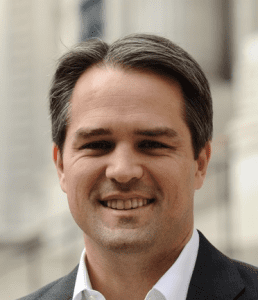With Finitive, Jon Barlow is bringing the level of efficiency to private credit P2P participants have long enjoyed.
Barlow describes Finitive as an online private credit marketplace. More than 1,500 institutional investors like family offices, credit funds, and wealth funds have registered.
Finitive’s foundation: Tech lessons learned from Eaglewood Capital
The concept originated with Eaglewood Capital, a company Barlow founded 11 years ago. It used software and algorithms to purchase P2P loans. After completing the first securitization of P2P loans and the IPO of the first publicly traded P2P debt fund, Barlow sold the company in 2015.
The lessons learned stayed with him, and Barlow later turned his attention to bringing the same concepts to the enterprise level. He credited the availability of granular data from P2P lenders that had never before existed.
“We wanted to use that data to screen borrowers, things like debt to income, city, and state of residence, and use of proceeds from the loan,” Barlow said. “We used to receive that information in the securitization market on a pooled basis, but we had never received it on a loan-by-loan basis. That was revolutionary, and using that data to predict loan performance was exciting.”
Borrowers get a response within one day
The process begins with the borrower. Finitive programmatically screens borrowers and structures unstructured data before presenting it to investors. Borrowers pay based on what they raise, while investors do not pay.
Borrowers can complete the entire process without talking to a human being. The data they provide is combined with external sources to produce a score that determines if they are accepted and which financing program they are placed into. There are programs for startups and different-sized firms.
Upon acceptance, determined in less than a day, borrowers receive a proposal, and their information is placed into a data room. The time it saves both parties enables them to begin discussions at an advanced level.
How Finitive saves investors time
Finitive’s system also identifies the investors most likely to fund that borrower and their specific needs.
“Our goal is to save both sides time,” Barlow said. “We don’t want investors wasting time on transactions irrelevant to their investment strategy. We don’t want borrowers wasting their time with investors who have no hope or probability of actually funding their transaction. The right people are talking to each other very rapidly.
“Investors love it; they get a lot of free information analysis and deal flow. We also use the investment preferences they provide to us to match them to the most relevant opportunities like Amazon programmatically would do with their recommended feature.

After several fluctuations, it is now an investor’s market
Before the COVID-19 pandemic, Barlow said it was a borrower’s market. Once the virus took hold, it was an investor’s market for a half-year. As the world adjusted, it suddenly reverted to the borrower, but the pendulum swung back to investors late in 2021.
Investors become more defensive and moved up the quality spectrum, Barlow explained. They became more selective and lowered their duration expectations.
“Credit spreads widened out during the pandemic,” he observed. “Initially, we saw credit spreads widen by more than 50%. I would say today it’s been a little less than that. We’re probably talking about 35-40% widening of credit spreads, albeit that is on top of rising short-term rates.”
Fresh capital sources livening the markets
Barlow said that one consistent piece of good news over the last five years had been the entry of new capital pools of private credit coming into the space. Banks, insurance companies, private equity funds, mutual funds, and others who have not previously operated in specialty finance building dedicated pools of capital to capitalize on these strategies. With that much fresh capital flowing in, the market should rebalance itself.
What’s attracting these new capital pools? Barlow estimates that private credit, in a typical transaction, delivers up to 400 basis points of additional yield compared to public vehicles.
“It’s the alpha that the sector creates. It’s one of the last inefficient financial markets on the planet, in my opinion, and it’s a massive market. So, you have many investors that, until recently, could not get adequate returns in the public fixed income markets but needed income or yields to satisfy their stakeholders.
“That is driving institutions of all types into the asset class.”
Securitization markets are-a changin’
Over the last six months, securitization markets for borrowers have mostly dried up, Barlow said. It forces them to rethink capital raising and look for fresh alternatives like Finitive.
Goldman Sachs places debt with borrowers in private markets, bypassing securitization markets. Expect more of that, Barlow predicted, as securitization markets prove themselves unreliable.
Concurrently, private capital markets are increasingly sophisticated. A positive, he believes, will displace much of the activity in securitizations.
“If you think about all the fees that go into a securitization, the rating agency fees, the trustee fees, the investment bank fees, you get a good cost of capital, but you pay a high price to access that,” Barlow said. “A lot of smaller borrowers can’t afford that price. They’ve been shut out from the securitization markets.
“There’s a silver lining in the weakness we’ve seen in the markets in the last six months. People are becoming aware of superior, lower costs, more efficient alternatives, like Finitive.”
The future is digital; opportunities abound
Expect the industry to become less relationship-driven, he added. Customer acquisition will become increasingly digital; borrowers could get term sheets in minutes instead of months.
“There’s a convergence between what has happened in the last decade in peer-to-peer lending,” Barlow said. “What happened in peer-to-peer and online lending at the B2C level is a guide to what will happen in a B2B context.
“And yet, almost no one is focused on this. Silicon Valley has invested very little money into B2B credit platforms; all the focus has been on b2c. That has to change. There’ll be a convergence and the same speed, convenience, and price transparency that you see in the B2C space today; as a result of the billions that have been invested, I think it will be present in five to 10 years in our space.”


